BrainPath Delivers New Treatment for Deadliest Strokes
 Recent studies showed 94 percent of patients were able to walk unassisted after surgery with BrainPath.
Recent studies showed 94 percent of patients were able to walk unassisted after surgery with BrainPath.
Subscriber Benefit
As a subscriber you can listen to articles at work, in the car, or while you work out. Subscribe NowA young Indianapolis-based company says it’s giving stroke victims new hope. NICO Corporation created a tool several years ago to access the brain, namely to remove tumors, but is now applying the technology to help patients overcome the deadliest, most debilitating form of stroke. After a hemorrhagic stroke, the company says patients are typically given a grim prognosis, but one Indianapolis brain surgeon is calling NICO’s BrainPath device “a huge paradigm shift.”
Hemorrhagic strokes are caused by a blood vessel bursting and account for only about 15 percent of strokes; most are caused by blockages. Contained by the skull, leaking blood crushes the brain, which is also toxic for the brain tissue. NICO Chief Executive Officer Jim Pearson says the standard of care for these patients “is to do nothing,” and they’re typically “parked in the ICU (Intensive Care Unit).”
With about a 50 percent mortality rate, hemorrhagic stroke patients haven’t had a surgical option “since the dawn of time,” says Pearson. But he believes NICO is now opening the door with the BrainPath device. About the width of a Sharpie marker and ranging from two to three inches long with a pointed tip, the device slides between the folds of the brain, gently opens a tiny path to repair the clot, then allows the tissue to move back together when the device is removed. NICO says, because the device disrupts less brain matter, patients experience fewer deficits.
Indianapolis-based Goodman Campbell Brain and Spine President Dr. Mitesh Shah has used the tool in the operating room. He says BrainPath represents a “major shift” in neurosurgery; surgeons are traditionally taught to take the shortest route to the tumor or clot, often cutting across critical tissue. However, the new device utilizes a longer—but less damaging—path in the brain.
“We’re finding now that there are white matter tracks that connect different parts of the brain, which have to be maintained,” says Shah, who is also vice chairman of neurological surgery at Indiana University. “This whole shift in paradigm has allowed us to approach those tracks in a parallel way, as opposed to cutting across them in a perpendicular route, because it’s the shortest distance.”
While BrainPath has been used to access tumors for several years, two recent studies are building momentum for using it to treat hemorrhagic strokes. One of the studies involved IU Health and about 30 Hoosier patients. The results showed 94 percent of patients were able to walk unassisted after surgery, and 95 percent showed clot reduction.
“Patients recover very fast [with BrainPath],” says Shah. “It’s astonishing; you can almost do outpatient surgery and send them home the next day using this technology with deep-seeded [clots]. The length of stay in the ICU is remarkably less. A loved one caring for these patients won’t have to be in the hospital for months at a time. It’s a huge shift in paradigm for the families and caregivers.”
NICO is nearing 5,000 completed cases for BrainPath’s use on tumors and strokes. Pearson says the technology is doing well in the marketplace because it’s producing better clinical results. He believes NICO’s most daunting task now is swaying more surgeons.
“Imagine the challenge: you’re going into a space that hasn’t had an answer for this ever. You’re telling doctors you can’t [use BrainPath] until you’re trained and you’re a small company,” says Pearson. “We’re doing this one by one, doctor by doctor, until we get big enough, strong enough and there’s enough evidence where it reaches a tipping point.”
Shah admits he was skeptical when BrainPath was first introduced to him.
“I didn’t really think that this would make a difference, to be honest. With my initial set of patients, the outcomes were much to my surprise…they’d bounce back from this kind of surgery very quickly,” says Shah. “It’s exciting. This is progress. While it’s a small number of patients in this [stroke] category, there are more patients out there who may benefit from this kind of technology. We think we can offer something that’s going to change the lives of many people.”
Shah describes the impact, so far, of using BrainPath on patients in Indiana who have suffered hemorrhagic strokes.
Pearson says surgeons are accepting BrainPath with growing enthusiasm.
Pearson believes BrainPath will come to be known as the way to safely access the brain for a long list of conditions.
